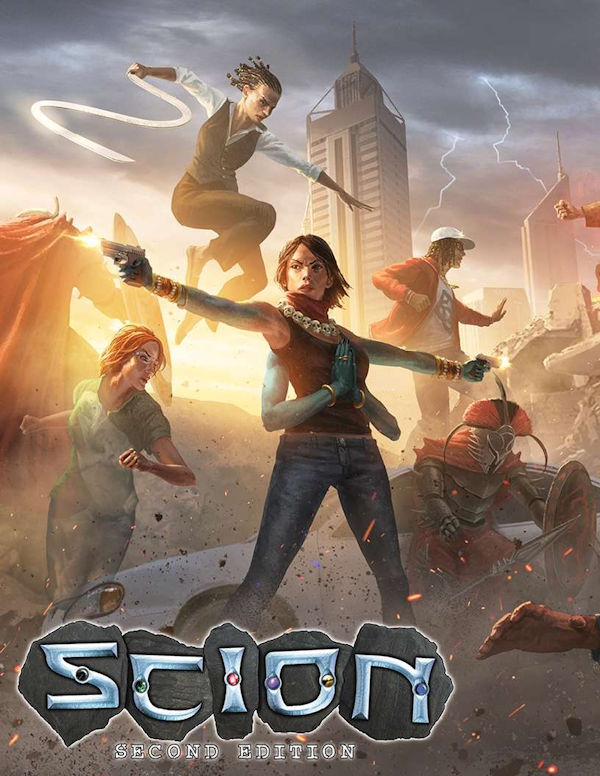 Okay, round
two of my review of Scion—the RPG from the good folks at Onyx Path that
lets you play the children of mythological gods in a modern world. Check out part
one of this review (Scion:
Origin), for more context and a description of the core rules of Scion
as a whole. (I’ll also note here that the art in Hero carries on the
high standard set by Origin. And the pantheon pictures show the gods in
both ‘classic mode’ and in modern clothes and you can have fun trying to spot
which god is which in each picture.)
Okay, round
two of my review of Scion—the RPG from the good folks at Onyx Path that
lets you play the children of mythological gods in a modern world. Check out part
one of this review (Scion:
Origin), for more context and a description of the core rules of Scion
as a whole. (I’ll also note here that the art in Hero carries on the
high standard set by Origin. And the pantheon pictures show the gods in
both ‘classic mode’ and in modern clothes and you can have fun trying to spot
which god is which in each picture.)
Whereas Origin dealt with characters who were the children of gods but hadn’t yet come into their power, Hero covers people who have been visited by a god and had their own divine powers revealed. Origin tier Scions are action stars. Hero tier Scions are supernatural superhumans.
Heroes are the frontline in the wars between gods and titans. Titans are dangerous and destructive personifications of forces of nature that, unlike gods, do not require worship to exist. Heroes are the monster-slayers, the questors, the exemplars and the human face of the gods.
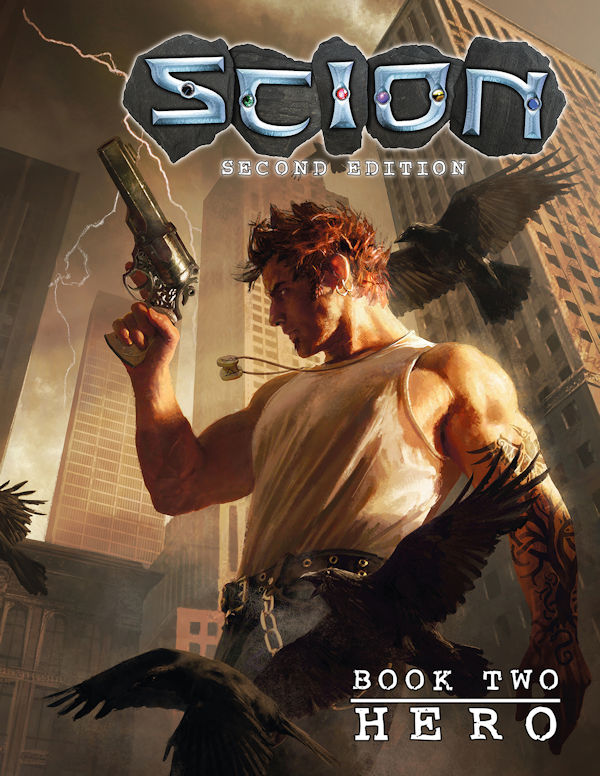 Player characters in Scion: Hero will battle giants and other outlandish creatures, foil the plots of titanspawn and rogue Scions, retrieve or create magical items, explore various afterlives and hidden worlds and lead entire cults to victory over their enemies. Yet even as they wield the powers of the cosmos and build their own legends, they will find themselves Fatebound—forced to recreate age-old tales with new human partners. Doomed love affairs, deadly rivalries, unbreakable friendships and so on.
Player characters in Scion: Hero will battle giants and other outlandish creatures, foil the plots of titanspawn and rogue Scions, retrieve or create magical items, explore various afterlives and hidden worlds and lead entire cults to victory over their enemies. Yet even as they wield the powers of the cosmos and build their own legends, they will find themselves Fatebound—forced to recreate age-old tales with new human partners. Doomed love affairs, deadly rivalries, unbreakable friendships and so on.
In short, this is a game of high action, high drama and high fantasy.
The book starts with “Grass”, a brief tale of a Japanese Scion’s origins and how they give her the strength to fight a rampaging fire giant. Featuring Kusanagi—the legendary grass-cutting sword. (It’s more impressive than it sounds.) “Grass” is well put together and gives a good snapshot of the main character’s past and present.
The other story in the book features Eric Donner—Scion of Thor and a character fans of the previous edition will remember fondly. This tale is kind of a slice of life story, with the daily grind replaced by battles against monsters and giants and the angst of having an absentee father.
Chapter One: Scions of the Gods
After “Grass” the book proper kicks-off with a discussion of the World and how heroes fit into it. Some of this is a retread of ideas discussed in Origin, such as the descriptions of different kinds of Scions.
We do learn a bit more about titans. Hero adjusts some of the mythologies it presents a little to justify its definition of the division between titans and gods. For example, Prometheus, who gave fire to humans and could be considered a ‘good’ titan is described as acting not out of compassion but out of a need to spark creativity.
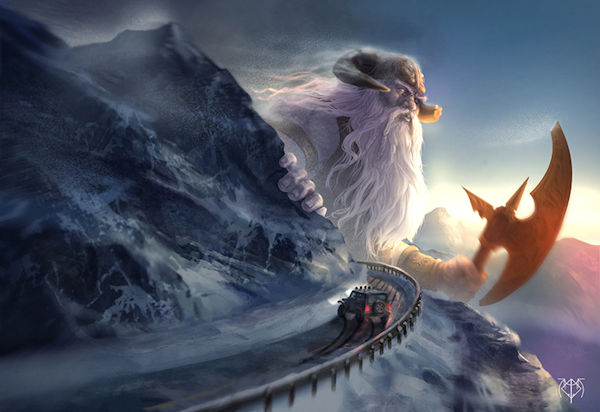
There’s also lot of info on cults, who are often a lot nicer than the cults you’d encounter in other games. Cults to the many gods are just a part of life in the World, mainly consisting of ordinary people with ordinary concerns who happen to go down to the temple on a Thursday to pray to the ceremonial forge or something like that. There are many different sorts of cult because the writers of Scion think of everything. Dining club cults, cults based around artefacts, historian cults, temple cults, cults in isolated lands beyond mortal ken and more.
Cults can help associated Scions but have their own plans, goals and even budgets. An arrogant hero may find their demands being ignored or creatively misinterpreted.

Law and order comes up too. Heroes have a relationship with the law that’s a bit like Superman’s relationship with Metropolis PD. Cops and judges tend to work around recognised Scions rather than against them. Law enforcement and government agencies will often call in heroes (unofficially) to deal with supernatural problems.
There’s a flipside to this. Much like superheroes, heroes are expected to protect ordinary mortals from uncanny and monstrous threats. In some ways they are more important than gods and demi-gods because they are ambassadors of the divine to the mortal world and advocates of mortal causes in the Overworlds and Underworlds. Heroes remember what it’s like to be mortal (usually), but they wield enough power to get things done on the mortal plane.
A huge amount of work has gone into explaining how all the various kinds of god and Scion could exist and interact throughout the ages. For example, the book describes how a god might have been born and slain multiple times and how conflicting myths about the same entity can exist and be true at the same time.
Chapter Two: Pantheons
This chapter presents ten different pantheons of gods and I’d call it the heart of the book. Mainly because I’ve been looking forward to reading it ever since I discovered that Origin’s entries on gods were extremely minimal.
This section doesn’t disappoint. It’s fascinating, well researched and often surprising, even for a card-carrying mythology maven like myself.
For all my interest in Norse mythology I never knew Heimdall had gold teeth or Freyr defeated an entire army while wielding a stag’s antler. Or that the Irish god of the dead, Donn, was once a mortal mariner who led the Gaelic invasion of Ireland and was shipwrecked and drowned for his trouble.

I liked that Loki is depicted as gender-fluid, which fits that god’s myths rather well.
The information on the Deva, the gods of South Asia, was particularly intriguing and made me realise my knowledge of Hindu mythology has only really scratched the surface so far. The glimpses offered by this book include tales of dances that could end the world, acts of inhuman asceticism, impossibly powerful weapons and a deposed Storm King who is still not to be trifled with.
The division between the Kami of earth and the Kami of heaven was also new to me (Kami are the gods and spirits of Japan). Though I don’t how much of the political manoeuvring between the two is from the original stories and how much was created for the setting. Either way it presents great opportunities for divine shenanigans in-game. Also new to me were the seven Kami of fortune, including such worthies as the long-headed Fukuruju who knows the secrets of longevity and resurrection.
The research that went into this book really is impressive. I was reading the entry on the cat-headed Egyptian goddess Bast and noticed it completely failed to describe her earlier incarnation as the crazed berserker lioness-goddess Sekhmet. “Hah,” I thought. “They missed something. Nerd rage activated.” A page or so later I found a sidebar explaining the links between Bast, Sekhmet, Bastet and another goddess called Het-Heru (Hathor). Before then I hadn’t even realised that Bast and Bastet were distinct entities. Yep, I got nerd-owned by a gaming book.
Any of the pantheons presented in this book could support an entire game-line on their own. That goes double for the Shen (the gods of China). It was never going to be possible to fit all Chinese mythology into a few pages, but what we do get is more than enough fun details to spark ideas and start off a campaign. I especially enjoyed the idea that both Guanshiyin Pusa, a Bodhisattva, and Confucius, a humble scholar with little time for gods, are surprised and not a little embarrassed to have been deified and embraced into the Shen Pantheon. Fans of Dynasty Warriors or Romance of the Three Kingdoms will get a kick out of learning that (just as in the real world), Guan Yu has also been deified.
The Teotl gods of Mexico on the other hand are one of the coolest pantheons and also the most disturbing.
Fearsome is the name of Itzpapalotl, for she is the Obsidian Butterfly. Bearing the untrammelled might of her dual nature, Itzpapalotl is both a Cihuateteo, a woman who died in childbirth, and a Tzitzimime, star demon.
Now that is just awesome.
The Teotl gods do raise an awkward question. At least some of them still demand human sacrifices. Most are content with donated blood or more abstract sacrifices such as the abandonment of a treasured friendship, but not all Teotl are satisfied with such meagre offerings. Scions of these gods would certainly have a lot of moral quandaries and disturbing decisions to navigate. I’m not sure how I’d GM that to be honest.
The writers hit the right notes with the Greek gods, whom they describe as “an endless argument of a family.” They are prone to infighting and indulging their own whims, but woe betide anyone who crosses them. They are also masters of the power of metamorphosis—transforming themselves or others into new shapes and creatures.
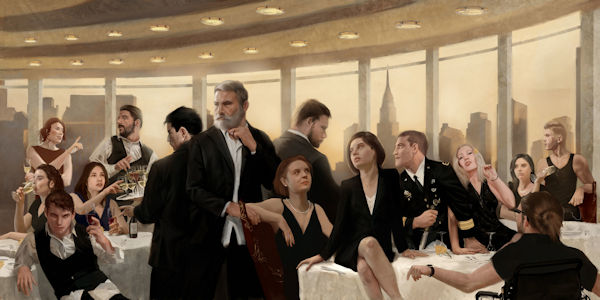
The Tuatha De Danaan of Ireland are as rambunctious, tricksy and sympathetic as I’d hoped. (Morrigan forever!) Their pantheon both wields and is subject to the power of Geasa—oaths and commands that cannot be broken without dire consequences. So much storytelling potential here!
There were a couple of pantheons that I knew little to nothing about before reading this book. Such as the Manitou, the gods of the Anishinaabek people of North America. And the Orisha of Yorubaland, who are linked to the Loa of Voudoun and number the god of Smallpox amongst their ranks. It was an absolute joy to learn about myths from these cultures whose tales haven’t been widely explored in pop culture at the time of writing. It seemed to me that these mythologies were presented respectfully (though as a white British person I’m not in a position to make a useful judgement about that), but regardless, to see them get recognition in an RPG must surely be a positive step.
The pronunciation guides included in each entry are a nice touch. Apparently, I’ve been pronouncing Aesir wrong all this time.
The pantheon descriptions are more than just a list of gods. They also explain the cosmology of the pantheon and describe associated creatures, titans, afterlives, powers and seats of divine majesty. The entry on the Manitou, for example, presents the idea that skunks are the shattered remnants of a giant man-eating skunk whose toxic spray was a plague upon the land. The Orisha entry offers the ability to possess your followers or to be possessed by an Orisha to gain certain benefits.
New lands are uncovered too. Lanka, formerly the kingdom of the demon king Ravana, has become an island refuge for monsters of all kinds. No one has yet been able gain control of the squabbling gangs of savage creatures that now populate Lanka, although rumours abound of Ravana’s return. I could easily see a GM running an entire campaign based in Lanka, with PCs trying to conquer the warring groups or prevent the demon king’s return.
Then there’s the Virtues and unique Purview of each pantheon and a section on what they think of other pantheons, which is bound to amuse any mythology geeks. And if you weren’t a mythology geek before reading this book then you might be afterwards. (Purviews are themes or forces or aspects of existence that gods have power over. Things like Passion or Sky or the Norse Pantheon’s power of the Wyrd, aka the knowledge and manipulation of Fate.)
The setting’s meta-mythology attempts to reconcile every story ever told and became increasingly complex the more I delved into it. Gods can be born directly from Primordials, not just from titans as with Greek mythology. Certain Primordials can also create Scions. At least one Primordial used to be a god. Some titans are fallen gods and one is an ascended Scion. Some gods are regarded as titans by other pantheons. The Shen routinely adopt titans into their ranks as gods. The Aesir and Tuathe De Danaan tend to marry their titans, producing new gods and titans in the process. The Orisha refuse to accept the validity of the term titan at all. The Manitou apparently view pretty much all supernatural beings as Manitou.
This complex approach to the World’s cosmology makes for a lot of flexibility and the potential for weird story arcs e.g. don’t just slay the dragon, rehabilitate her into becoming the goddess of cherry trees! However, it got to the point where I thought that the game would be better off just scrapping the god, titan, Primordial trichotomy altogether. Why not just have gods who are opposed to humanity’s continued existence and gods that are in favour of it? (I have heard that Onyx Path are working on a book called Titanomachy that may answer this question. Watch this space, I guess.)
If you like myths and legends then it’s great fun to just comb through the pantheon entries and learn a bunch of new stories. You will be left with a few questions that might send you off down the internet rabbit-hole though. Such as: why did Odùduwà believe sending three lice to each of the kings of Benin was a good test of whether they deserved a god-king to rule over them?
And these entries do have the desired effect—they get you thinking about the kinds of campaign and adventure you could run in this setting. Personally, having seen how many gods are fond of dancing I was very tempted by the idea of a heroic dance troupe who go from one strange land to another, putting on shows and solving problems with grace and rhythm.
Chapter Three: Character Creation
Character creation in Scion: Hero builds on the system in Scion: Origin. But with greater power comes greater complexity. As well as creating three Paths, ranking those Paths, picking Skills, ranking Attributes, picking a favoured Approach and assigning dots—you now pick three Callings, earn Knacks from them and choose some Boons and Birthrights. You’ll certainly need at least one Session Zero to get this all worked out and going forward you’ll need to keep track of your Legend and your Fatebindings too.
In fairness. I can’t see many players complaining about having to pick out more Kewl Powerz! for their character. And I appreciated the example of character creation that was interspersed with the rules. It definitely helped me to get this process straight in my mind.
Chapter Four: Traits
This chapter delves into the nuts and bolts of roleplaying divinity. It covers the gaining of divine power in the form of Legend and the powers it unlocks. There’s also a system called Sacrifice by which a Scion can restore spent Legend or gain temporary hits of divine power. Sacrificed items must be ceremonially offered to a greater power but can be anything from a precious relic to a living human, so long as it takes time and effort to acquire and/or its loss will have serious consequences. (Why are the player characters breaking into the British Museum and ransacking the Hawaiian exhibition? Because a Scion of Pele wants to retrieve an artefact associated with her mother to sacrifice to her.)
Scions can also accept Fatebinding to restore Legend—they act in accordance with one of their Callings and dance to the whims of Fate, thus earning some of the power invested in that role. Fatebinding was much discussed in Origin but not mechanised as such. Hero explains a Scion can recharge a point of Legend by allowing an NPC to be Fatebound to them—becoming a part of their story, whether as the hapless boyfriend they must protect, the rival who will hound them at every turn or the bright-eyed apprentice who could get killed in the line of duty. Fatebound characters become almost an extension of the Scion in gameplay terms. (Why does a Scion of Zeus get into another fling that is sure to end badly? Because acting out the disastrous stories associated with his ancestor will grant him power, which the player will appreciate even if the character does not.)
Fate won’t literally brainwash a mortal into playing a role, it just finds a person who fits that role and nudges them along with whatever inducements are necessary.
Fate is not above low cliché.
In rules terms, Fatebound characters feel a lot like Aspects in the FATE system. You can Invoke them once per session to get a small benefit or Compel them once per session to earn a point of Legend in return for accepting an obstacle or difficulty relating to that character. Unlike FATE, the more you Invoke a Fatebound bond the more likely it is to become permanent. The highest level of Fatebinding transcends death itself. Your rival got killed? Well now they’re gonna haunt you. It seems like a solid system that rewards players for playing out their character’s archetypal role but makes them wary of it too. Yes, that Leprechaun could help you out here, but do you really want him to become your BFF forever? Want to get some extra Legend by saying your nemesis is the person who set zombie jaguars on the party? Fine but remember he’s only going to get more dangerous if you keep paying attention to him.
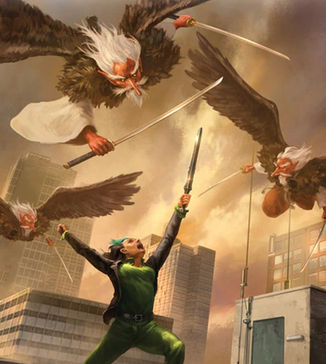 I like the huge roleplaying potential this system offers. It allows for a lot of player-driven storytelling. With the right group of players and player characters you could pretty much give the Scions a little nudge to get things started and then leave the story to develop on its own.
I like the huge roleplaying potential this system offers. It allows for a lot of player-driven storytelling. With the right group of players and player characters you could pretty much give the Scions a little nudge to get things started and then leave the story to develop on its own.
Callings themselves are well explained and definitely lend the game a mythic, archetypal quality. Warrior, Trickster, Judge and Sage all resonated with me and I could instantly think of examples of gods and characters from fantasy fiction who fitted those archetypes.
Virtue is a trickier system to internalise and I’m not sure if it was really required alongside everything else that influences how Scions behave. Honestly it feels like a holdover from the World of Darkness games. Each pantheon has two competing Virtues such as the Orisha’s Tradition and Innovation. Acting in accordance with one Virtue moves you along a track towards exemplifying it and away from exemplifying the other Virtue. I guess this helps to differentiate Scions and gods of different pantheons and ramp up the personal drama inherent in the game.
Birthrights
This section offers mentors, items and followers to aid heroes in their endeavours. The section on Guides provides a dizzying array of mystical creatures and magical practitioners to aid your Scions. Including but not limited to Tengu, fortune tellers, the Morrigan’s crows and even White Eyebrow—The Betrayer of Shaolin.
Also a standout is the section on Relics, aka magic items. Relics are hugely customisable. You can make a perfectly silent gun, a cursed vase, a power-up potion, a lightning bolt, a cloak of demon-smiting which must be recharged after each use by chanting mantras over it, and pretty much anything else you’ve ever heard of or can imagine.
There’s tons of readymade relics as well. Winonah’s Jingle Dress, Elfshot, a smartphone that always has reception even in worlds beyond The World, a Bear Warrior’s Bludgeon, a magical muscle car, Icarian Wings, a personal constellation, The Red Strings of Fate, the Green Dragon Crescent Blade and many more. I had to stop reading this section a couple of times to laugh like a gleeful supervillain as I thought about all the possibilities on offer.
While comprehensive rules are offered in this section for creating followers and monstrous pets, you’ll need to backtrack to the pantheons section to get examples.
Chapter Five: Powers
This chapter contains long lists of heroic abilities and is broken down into Knacks and Purviews.
Knacks
Callings grant Heroic Scions straight up divine superpowers that completely overshadow the subtler Knacks offered by Origin. With the right Knacks you can, amongst other abilities:
- Raise whole buildings from dust.
- Stand as a sleepless guardian who needs no sustenance beyond the sight of her charge.
- Perform surgery despite the fact that the only tools you have on hand are two toothpicks and a sausage roll.
- Ingest a toxin, ignore its effects and secrete an antidote to it.
- Make it so it is literally impossible for a mortal or less powerful creature to escape you once you start hunting them.
- Inflict dire consequences on anyone who breaks an oath to you. Alternatively, make anyone who lies to you suffer an immediate injury.
- Ignore injuries as long as you have followers to bolster you.
- Fade from the memories of mortals.
- Shapeshift.
- Create a temporary double of yourself.
- Stab someone to death with a teacup.
Oh, and you get to learn what different pantheons smell like, so there’s that.
There’s also a lot of ‘gamey’ Knacks that give you bonuses to your rolls in certain situations, e.g. when investigating someone or when smashing the patriarchy. Less superpowers and more the ability to fulfil a certain role such as Judge, Warrior or Trickster with inhuman competence. In general I felt as though a lot of these powers were story hooks in themselves. I didn’t look at every single power and say, “Wow that’s cool,” but I looked at a lot of them and started thinking of characters I’d encountered or would like to create. And you can’t ask for much more from an RPG.
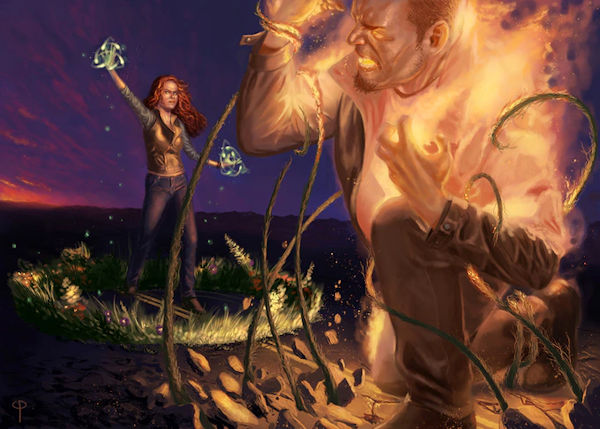
It was at this point in my read-through I realised—this game feels like urban fantasy in the style I love to read and to write. It’s a world of fey creatures and inescapable oaths and mentors who turn out to be beings of legend. It’s not just American Gods—it’s Sandman, Horns, October Daye, Rivers of London, Matthew Swift, Mythago Wood, Faerie Tale, Lucifer, Welcome to Night Vale, War for the Oaks, The Skyscraper Throne, Crescent City, Swamp Thing, The Almighty Johnsons, and Delphic Division. If you enjoyed any of those series or books, then you should check Scion out. (Especially if you’d like to recreate one of those settings in an RPG.)
Purviews
Purviews are another sort of divine power. The ability to control aspects of reality, rather than embodying particular roles. With the use of Legend, a Purview can be wielded to do almost anything that fits its theme. But usually it’s more efficient to buy the Boons a Purview grants access to. Boons are specific powers distinct from Knacks. (Though there is definitely crossover between the effects of certain Knacks and Boons.)
The list of Purviews is pretty darn exhaustive. Consider Passion, Love, Beauty and Fertility are all separate Purviews. Same with Sky, Stars, Sun and Moon. Here’s just a tiny sample of the Boons on offer. You can:
- Make someone fall in love with you.
- Start a riot.
- Make a corpse talk.
- Take on the powers of an animal.
- Curse someone to be hideous.
- Perform what amounts to a Jedi Mind Trick.
- Run across water.
- Pull money out of the air.
- Teleport.
- Ignore lines at the Post Office. (No really, the Shen have an innate power to sidestep any form of bureaucracy that gets in their way).
All in all, there are literally hundreds of powers in this book. Which is definitely a selling point as far as I’m concerned. And GMs are encouraged to reward players’ creativity in coming up with new ways to use their powers. Even if a player is trying to use a Purview in a way that doesn’t make sense to the GM, the game encourages them to allow it and just add a Complication to the roll. Keep things fun and keep things moving, that’s the mantra for a Scion storyteller.
Chapter Six: Mythic Storytelling
While the Storyteller in Onyx Path games is just their name for the GM I have to admit this section really hones in on the nature of stories.* It references the Hero’s Journey and offers non-Western alternatives to it. It discusses the use of tragedy and how that can be as satisfying as victory. You can tell the writers have delved deeply into myths and legends in a genuine attempt to use RPGs to recreate how they play out. I don’t think I’d use all the campaign styles they suggest. But it’s nice to have the options and to be encouraged to think about the structures of the tales I tell.
*Editor’s Note* “While this is true for the licensed White Wolf games under their Storyteller/Storytelling Systems, Scion is an Onyx Path game and uses the Storypath system. Storypath’s term for the GM is the “Storyguide.” The only time “Storyteller” appears in Scion: Hero is the lowercase general sense of “someone who tells stories” and not as a specific game term.” – Ian, Onyx Path Publishing
There’s also a series of plot hooks to get you thinking about adventures for your campaign (or chronicle, if you prefer). This one in particular drove home to me one of the unique selling points of Scion: Hero.
Theft: The villain takes something of value from the hero or the World. In Hero-tier games, the scale of thefts is always grand. These villains don’t rob banks. They steal faces, dreams, shadows, or mountains.
Go big or go home. That’s Scion: Hero’s message.
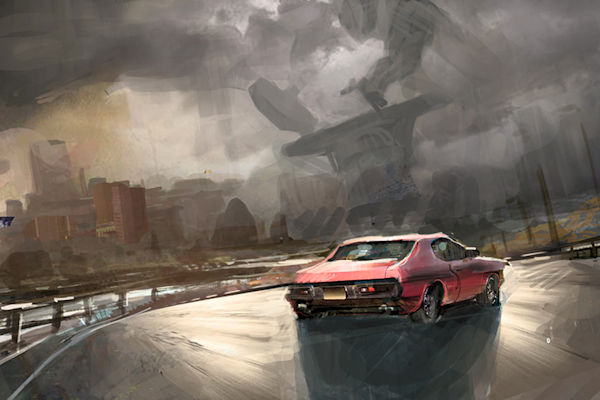
And the plot seeds on offer do have that mythic quality to them. Insult Zeus, kill the king of snakes, build a city to please a dragon.
What I really liked was the writers then suggested how you could create a new adventure from each of these plot seeds once they have been resolved, e.g. the people in the dragon’s city are starting to look a bit draconic themselves, maybe you should look into that? I don’t recall ever having seen this before in an RPG book and it’d be a great help for new GMs or anyone suffering from RPG writer’s block.
Antagonists
The Antagonists section takes a different approach to most RPG bestiaries. Scion assumes you’ll use its pretty extensive Antagonist creation system to generate your own villains. So, although the bestiary isn’t particularly large most of the creatures on display are examples of how to create a certain type of creature, e.g. undead, chimeras, evil spirits and rogue Scions. While I love a good bestiary, I wasn’t put out by this. It’s really easy to make your own antagonists in Scion and I was pretty much planning to do just that in any game I ran. Again, you can nip back to the pantheons chapter to get ideas if you want.
One more quote.
Pop culture has had its way with virtually every example of the living dead, twisting it into versions that have all but replaced their mythological inspirations. We encourage you to do a little reading—there are versions of all of these stories that are both weirder and more interesting than anything you’re likely to see on a screen.
Damn right. You preach that good word Scion: Hero. Who really wants to face another pack of shambling Romero-style zombies? Instead try tracking down a bloodsucking Penanggalan’s discarded body before she returns to stuff her dangling entrails back into it and sit her head back onto its neck.
Appendix: Legendary Creatures
This section mostly updates the options for playing some of the supernatural creatures from Origin. I love that they included creatures like the Nuckelavee, though I would have liked to see a bit more of an explanation of that creature for the sake of people who haven’t made a study of the mythology of the Orkney Isles.
Two new additions are the Prophet and the Cassandra (who is a prophet no one except Scions will believe). Handling characters who can foresee the future is always difficult in an RPG, where even the GM isn’t all that sure what’s going to happen next. But the writers of Scion: Hero manage to pull off some pretty sweet and gameable mechanics for this power. Good for them.
Conclusion
Should you buy this book?
I think so. You’ll need Scion: Origin in order to make it work so you can always test the waters by buying that book and taking the ruleset for a spin before you commit. And it is a good ruleset in my opinion.
Scion: Hero itself is the new home of mythological fantasy. It’s diverse, flexible and stuffed full of powers, creatures and magical items for you to play with. There’s no end of plot seeds and ideas for campaigns and adventures buried in its pages. It offers a huge pile of fascinating lore that’s fun to pick through even if you don’t plan to use it in a game. I’ve read academic books of mythology that provided me with less information on the subject than this roleplaying book did. (Or at least, less fun information.)
You could get years of play out of following its every cue and plot point or even from exploring one corner of its vast setting. Or you could use it to simulate just about any urban fantasy setting you’d care to name or invent.
Go on.
Be a Hero.

I received a free copy of both this book and Scion: Origin in return for an honest review.


Minor correction: “While the Storyteller in Onyx Path games is just their name for the GM…”
While this is true for the licensed White Wolf games under their Storyteller/Storytelling Systems, Scion is an Onyx Path game and uses the Storypath system. Storypath’s term for the GM is the “Storyguide.” The only time “Storyteller” appears in Scion: Hero is the lowercase general sense of “someone who tells stories” and not as a specific game term.
Thank you! I’ve added your correction to the article.